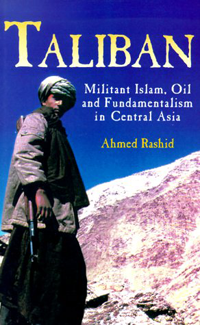
- Taliban: Militant Islam, Oil and Fundamentalism in Central Asia
- Yale University Press (2001)
- Bookstore Finder
In the Afghan province of Kandahar, Canadian soldiers have marched -- it is hard not to say unwittingly -- into a second Taliban uprising. This one is almost as poorly understood as its predecessor, which saw the Taliban seize power in the mid-1990s. A level of ignorance pervades the debate about Canada's role in the country.
Consider the folly offered by some anti-war activists that to pull international troops out would lead to an Afghan democracy. Instead it would lead to a horrific civil war.
On the other hand, if Canada and the rest of NATO don't change tactics quickly, the Taliban will regain complete control over the South, and the country will slide again into full-fledged civil war.
It's important then, that Canadians engage in a debate about what our soldiers and diplomats are doing in Afghanistan. But debate should be based on information, not ideology, and there is plenty of information available.
Women as enemy
A good starting point is the work of Ahmed Rashid. Rashid, an acclaimed Pakistani journalist, has written extensively on religious insurgencies and terrorism in Central Asia. In Taliban: Militant Islam, Oil and Fundamentalism in Central Asia, he tells the definitive story of the Taliban's rise to power.
The foot soldiers in the first generation of Taliban insurgents were mostly recruited from Afghan refugee camps in Pakistan. "They were literally orphans of the war, the rootless and the restless, the jobless and the economically deprived with little self knowledge," Rashid writes.
"The mullahs who had taught them stressed that women were a temptation, an unnecessary distraction from being in service to Allah. So when the Taliban entered Kandahar and confined women to their homes by barring them from working, going to school and even from shopping, the majority of these madrassa boys saw nothing unusual in such measures. They felt threatened by that half of the human race which they had never known and it was much easier to lock that half away, especially if it was ordained by the mullahs who invoked primitive Islamic injunctions, which had no basis in Islamic law. The subjugation of women became the mission of the true believer and a fundamental marker that differentiated the Taliban from the former Mujaheddin."
There is nothing to suggest the new Taliban's attitude to women is any different. From a humanitarian point of view, pulling Canadian troops out of Kandahar and ceding control of the province to the Taliban would be disastrous.
'Every country's payroll'
But that's not to say the alternative is attractive. The country is riddled with corrupt warlords and gangsters who, like the Taliban, never really went away after the U.S. invasion in 2001. Many now hold positions in President Hamid Karzai's government. The northern Uzbek commander Abdul Rashid Dostum is a prime example. Dostum, now a military chief of staff, once fought alongside the Soviets as an officer in the Afghan army. He continued to fight for the Soviet-supported Afghan government until it was clear that Kabul would fall to the mujahedeen in 1992. Then the formerly godless communist joined the ultra religious mujahedeen. "The hard-drinking Dostum then became a 'good Muslim,'" according to Rashid.
"He had, at one time or another, allied himself with everyone...and betrayed everyone with undisguised aplomb. He had been on every country's payroll receiving funds from Russia, Uzbekistan, Iran, Pakistan and lately Turkey. In 1995 he managed to be on the payroll of both Iran and Pakistan, then at daggers drawn over the Taliban. Although he controlled only six provinces in the north, Dostum had made himself indispensable to neighbouring states."
In 2001, Dostum and other warlords in the Northern Alliance became indispensable to the United States, supplying the manpower for its invasion of Afghanistan. Today they are still well armed and well funded, and they feel entitled to power. Whatever happens in Afghanistan, dealing with them will be a problem.
While Rashid painstakingly documents the factors on the ground in Pakistan, Afghanistan and Central Asia that led to the rise of the Taliban, Steve Coll's work focuses on the global geopolitics that has fed the conflict since the late 1970s. In his Pulitzer Prize-winning Ghost Wars: The Secret History of the CIA, Afghanistan, and bin Laden, from the Soviet Invasion to September 10, 2001, Coll looks at how a relationship between Saudi, U.S. and Pakistani intelligence agencies fed the violence in Afghanistan.
Alarmed at the atheistic Soviets' invasion of Muslim Afghanistan in 1980, the Saudis soon began fuelling cash to local insurgents. The CIA, still stinging from public attacks on their operations in South America in the 1970s, stuck mostly to cash contributions as well. That left Pakistan's ISI to decide who got the money. And the ISI favoured hard-line Islamic mujahedeen factions.
Brutal saviours
After the Soviet Union left Afghanistan in 1989, the Americans soon lost interest, with predictable results. At one point in the book Coll recounts the last days of Afghanistan's communist government, headed by Najibullah (many Afghans use just one name). As the mujahedeen closed in on the presidential palace in 1992, Najibullah told reporters, "If fundamentalism comes to Afghanistan, war will continue for many years. Afghanistan will turn into a centre of world smuggling for narcotic drugs. Afghanistan will be turned into a centre for terrorism."
A few pages later, Coll quotes a memo from the American Ambassador, Peter Tomsen, who was trying to convince his superiors in Washington not to abandon the country.
He warned of "Islamic extremists' efforts to use Afghanistan as a training/staging base for terrorism in the region and beyond."
But with the Cold War over, Afghanistan was no longer a priority; Tomsen and his embassy staff were withdrawn and a new stage of the civil war began. "Kabul plunged into violence and deprivation in 1993," writes Coll.
"The old mujaheddin leaders realigned themselves in bizarre temporary partnerships. They fought artillery duals along Kabul's avenues, dividing the city into a dense barricaded checkerboard of ethnic and ideological factions...Roads closed, food supplies shrank, and disease spread. About ten thousand Afghan civilians died violently by year's end."
A couple more years like that and Kabulis welcomed the Taliban when they swept into the city. Residents, though, were quickly horrified by their draconian new rulers.
One of the Taliban's first acts was to capture Najibullah, who had taken asylum in a UN compound. The Taliban tortured the former president and his brother, castrated them and hung them from a lamppost near the presidential palace now occupied by Hamid Karzai.
A generation away
That was 1996. A decade later, with the country still infested with warlords and a rising Taliban insurgency in the south, the picture is brighter. But only because Afghanistan is on the brink of civil war rather than engulfed in it. Karzai's government -- as fractured and flawed as it is -- probably wouldn't last a week if international forces were not there to maintain some semblance of security.
The attention to detail in both these books is almost startling. What emerges is a complex web of tribal, ethnic, religious, regional and global interests. The picture is complicated, but stark, and neither author falls into a deeply ideological interpretation of events. While the books don't offer any easy answers, we can certainly learn from the authors' disciplined approach, as well as their subject matter.
There is much in these books to fuel conspiracy theories about why the U.S., Canada and other countries invaded Afghanistan five years ago. For example, both authors devote many pages to an elusive pipeline that would run through Afghanistan to massive Central Asian oil reserves.
But while oil may be one of the reasons for western involvement in Afghanistan, it isn't the only one. There are more important reasons for being there, like protecting human rights and fostering a government that respects the rule of law and rejects international terrorism. These lofty ideals cannot be achieved overnight, or in five years, or 10 years.
The complicated history laid out in Taliban and Ghost Wars suggests that it will take at least a generation for Afghanistan to reconcile with its dark past. Canadians may decide they are not up to the challenge, that the risks are too high, or that it's not in our national interest. But if we decide to withdraw, after an honest and informed debate, we should at least understand the consequences of that decision.




